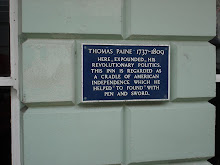The end of last year brought a new incumbent to the garage. It is a 1928 Alvis (a 12/50 to use the nomenclature) and it's rather lovely station wagon body was added in Shropshire in 1938 by the first owner, a local doctor. By the time he sold the car around 1970, the venerable conveyance was said to have covered over 300,000 miles! The new owner then thoroughly rebuilt the car although the woodwork was mostly (and surprisingly) sound. I became the third owner from new when I relieved him of the Alvis at the tail end of last year. Thanks to his considerable mechanical skills, the car is in fine fettle.
Travelling in a vehicle of this age is reminiscent of being in a pre-war railway carriage - all leather, wood, and sliding up and down windows, ebony handles and nice levers to pull and push. There are traps for the unwary - the gearchange lever is to your right with what looks like another one next to it. This is a device for manually dipping the headlamps and by pulling or pushing, they tilt up or down. Another vertical lever actuates the handbrake. The resulting group is akin to a railway signal box. The accelerator pedal, not wishing to be left out of the fun is positioned in the middle between the clutch and the foot brake. Although I have driven many cars of this era and am reasonably proficient in the black art of double-declutching, my trial drive with the previous owner was hopeless. I simply failed in every attempt to progress from 2nd to 3rd gear in the aptly named 'crash' gearbox, my halting progress being accompanied by hideous graunching noises. After an hour of this misery in the country lanes around the Midlands countryside we gave it best and returned to the vendor's home - he now driving effortlessly and changing gear silently the while. Confessing to my wife my inability to perform the most basic function on this car she dismissed it with a cheery wave and said that she was sure everything would be alright, having utmost confidence in my driving skills! We bade our farewells to the trembling vendor and his wife exhorting them to process to the rear of their home, less to be able hear the ghastly progress of their much-loved vehicle. As it happened...nothing happened...or at least I magically changed gear almost silently and we were on our merry way back to Sussex via Essex. Put it down to nerves and stress. The previous owner had the vehicle for over forty years and knew every inch of it and I think it was preying on my mind.
Now we've had a chance to get to know one another better, the Alvis and I, the relationship has settled down a bit. Gear changing is still no bed of roses and if I miss that all-important shift from 2nd to 3rd there's nothing for it but to stop, no matter where, and start all over again...embarrassing to say the least. We've had some magical moments though, like the first time we took three of the grandchildren out on a jaunt, they were absolutely convulsed with laughter at my attempts to change gear and at the attendant comic mechanical noises. Or the picnic on the village green at Staplefield where, with the tailgate let down and the gas stove on and kettle whistling, tea and bacon sandwiches were dispensed to grateful chums. The battered aluminium kettle was perfectly in keeping, but had we been using a nice burnished Primus stove instead of Camping Gaz, the scene could have been pre-war.










